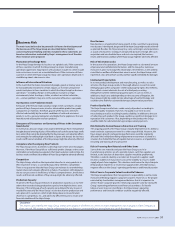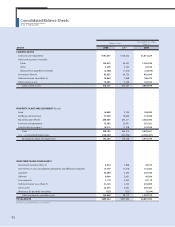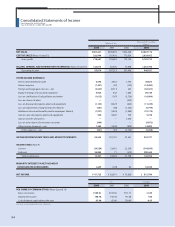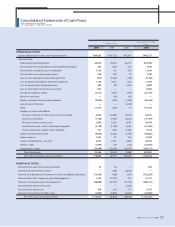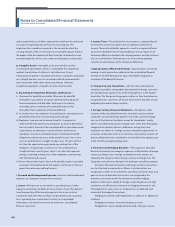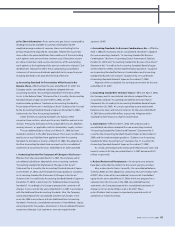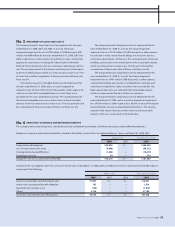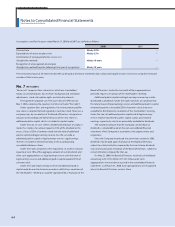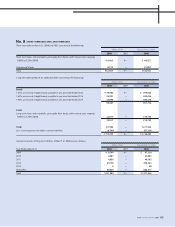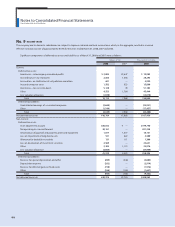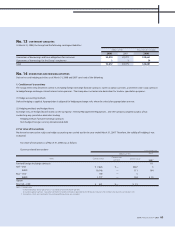Pentax 2008 Annual Report Download - page 62
Download and view the complete annual report
Please find page 62 of the 2008 Pentax annual report below. You can navigate through the pages in the report by either clicking on the pages listed below, or by using the keyword search tool below to find specific information within the annual report.
Notes to Consolidated Financial Statements
Hoya Corporation and Subsidiaries
undiscounted future cash flows expected to result from the continued
use and eventual disposition of the asset or asset group. The
impairment loss would be measured as the amount by which the
carrying amount of the asset exceeds its recoverable amount, which is
the higher of the discounted cash flows from the continued use and
eventual disposition of the asset or the net selling price at disposition.
g. Intangible Assets—Intangible assets are carried at cost less
accumulated amortization, which is calculated by the straight-line
method. Amortization of software is calculated over 5 years.
Amortization of patent is calculated over 8 years. Goodwill is amortized
on a straight-line basis over its estimated useful life determined for
each investment, which does not exceed 20 years. However,
insignificant goodwill is charged to income when incurred.
h. Accounting for Significant Allowances and Reserves—
i) Allowance for doubtful receivables: Allowance for doubtful
receivables is provided at an amount determined based on the
historical experience of bad debts with respect to ordinary
receivables, plus an estimate of uncollectible amounts for
receivables from companies in financial difficulty.
ii) Accrued bonuses to employees: Accrued bonuses to employees are
provided based on the estimated amount to be paid.
iii) Employees’ pension and retirement benefits: To prepare for
retirement benefits payment to employees, an amount deemed to
have accrued at the end of the consolidated fiscal year under review
is provided as an allowance in certain divisions and overseas
subsidiaries, based on estimated amounts of retirement benefit
obligations and pension assets at the end of the year. Past service
costs are amortized on a straight-line basis over 10 years, which is
less than the expected average remaining working lives of the
employees. Actuarial gains and losses are also amortized on a
straight-line basis over 10 years, which is less than the expected
average remaining working lives of the employees, commencing
with the following fiscal year.
iv) Reserve for periodic repairs: Reserve for periodic repairs is provided
at amount estimated based on the expenses of the latest extensive
repairs for continuous melting furnaces.
i. Research and Development Expenses—Research and development
expenses are charged to income when incurred.
j. Leases—All leases are accounted for as operating leases. Under
Japanese accounting standards for leases, finance leases that deem to
transfer ownership of the leased property to the lessee are to be
capitalized, while other finance leases are permitted to be accounted
for as operating lease transactions if certain “as if capitalized”
information is disclosed in the notes to the lessee’s consolidated
financial statements.
k. Income Taxes—The provision for income taxes is computed based
on the pretax income included in the consolidated statements of
income. The asset and liability approach is used to recognize deferred
tax assets and liabilities for the expected future tax consequences of
temporary differences between the carrying amounts and the tax bases
of assets and liabilities. Deferred taxes are measured by applying
currently enacted tax laws to the temporary differences.
l. Appropriations of Retained Earnings—Appropriations of retained
earnings at each year end are reflected in the consolidated financial
statements for the following year upon shareholders’ approval or
resolution of the Board of Directors.
m. Foreign Currency Translations—All short-term and long-term
monetary receivables and payables denominated in foreign currencies
are translated into Japanese yen at the exchange rates at the balance
sheet date. The foreign exchange gains and losses from translation are
recognized in the statements of income to the extent that they are not
hedged by forward exchange contracts.
n. Foreign Currency Financial Statements—The balance sheet
accounts of the consolidated overseas subsidiaries and associated
companies are translated into Japanese yen at the current exchange
rates as of the balance sheet dates except for shareholders’ equity,
which is translated at historical exchange rates. Other than the portion
charged to the minority interests, differences arising from such
translation are shown as “Foreign currency translation adjustments” in
a separate component of net assets. Revenue and expense accounts of
the consolidated overseas subsidiaries are translated into Japanese yen
at the monthly average exchange rates.
o. Derivatives and Hedging Activities—The Group uses derivative
financial instruments to manage its exposures to fluctuations in foreign
currency exchange rates. Foreign exchange forward contracts are
utilized by the Group to reduce foreign currency exchange risks. The
Group does not enter into derivatives for trading or speculative purposes.
Derivative financial instruments and foreign currency transactions
are classified and accounted for as follows: (a) all derivatives are
recognized as either assets or liabilities and measured at fair value, and
gains or losses on derivative transactions are recognized in the
statements of income and (b) for derivatives used for hedging
purposes, if derivatives qualify for hedge accounting because of high
correlation and effectiveness between the hedging instruments and
the hedged items, gains or losses on derivatives are deferred until
maturity of the hedged transactions.
Hedging instruments and hedged items as of March 31, 2008 were
as follows:
Hedging instruments: Forward exchange contracts
Hedged items: Loans payable denominated in foreign currency
60



